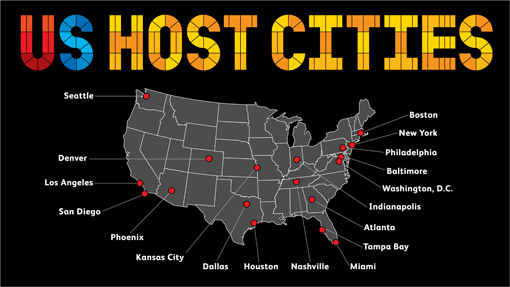By Duncan Mackay
January 12 – The United States today announced the 18 cities that could host matches if the country’s bid to host the World Cup in either 2018 or 2022 is successful.
The cities chosen following an eight month selection process are Atlanta, San Diego, Phoenix, Dallas, Seattle, Denver, Tampa, Indianapolis, Baltimore, Nashville, Kansas City, Houston, Miami, Philadelphia, Los Angeles, Washington DC, Boston and New York.
A total of 21 stadiums have been chosen with Dallas, Los Angeles and Seattle all having two potential venues chosen.
They cities are in four different time zones.
David Downs, the USA Bid Committee executive director, said: ”By virtue of the quality of our cities and stadiums, it was very difficult to reduce the field to the maximum of 18 established by FIFA.
“We consider it a meaningful indicator of the significant growth of soccer in this country that we can put forth such a technically sound bid without four cities that served as hosts for the first FIFA World Cup in the United States in 1994.
“The emergence of passionate followings for the sport and state-of-the-art venues throughout the country has strengthened our ability to put together a truly national bid to host the FIFA World Cup in 2018 or 2022.”
All the cities have signed legal documents which makes them fully compliant with FIFA regulations to host the World Cup, officials claimed.

The biggest surprise was that Chicago’s Soldier Field, which hosted matches during the 1994 World Cup, was overlooked.
Sunil Gulati, the President of the United States Soccer Federation (USSF), blamed their omission on “Olympic fatigue” following their unsuccessful bid to host the 2016 Games and the fact that the stadium was smaller than its rivals.
Rejected along with Chicago were Charlotte, Cleveland, Detroit, Jacksonville, Oakland, Orlando, St. Louis and San Francisco.
Four of those cities [Chicago, Detroit, Orlando and San Francisco] were chosen when the United States hosted the World Cup in 1994.
The stadiums chosen have an average capacity of 78,000 giving the US the potential to sell five million tickets, 33 per cent more than were available in 1994, Downs said.
The cities were picked from a short-list of 27, which was originally reduced from more than 50.
Unlike the rest of its rivals, none of the stadiums are being built just for the World Cup.
It is expected that FIFA would further cut the list if the US bid is successful, down to 12.
Gulati said: ”To truly build the game the more venues we have the better.”
Gulati said that discussions were already taking place about where the opening match and final would take place but no decision had been made yet.
The Rose Bowl, which hosted the final in 1994 when Brazil beat Italy on penalties, is one of the two venues chosen in Los Angeles.
Gulati said: ”The United States is equipped and ready to offer FIFA the opportunity to host a passionate and successful World Cup where fans, teams, partners and media can experience the beautiful game at its highest level while allowing the world soccer family to focus on the utmost mission of the game that benefits the world as a whole.”
Contact the writer of this story at zib.l1745643955labto1745643955ofdlr1745643955owedi1745643955sni@y1745643955akcam1745643955.nacn1745643955ud1745643955.
Related stories
January 2010: Seattle is America’s most popular choice to host World Cup matches
January 2010: Spike Lee joins USA World Cup Bid Committee
December 2009: USA World Cup Bid Committee meets for first time
December 2009: New York City Mayor joins USA World Cup Bid Board
December 2009: US angry after Spain and Portugal scupper presentation

.jpg)